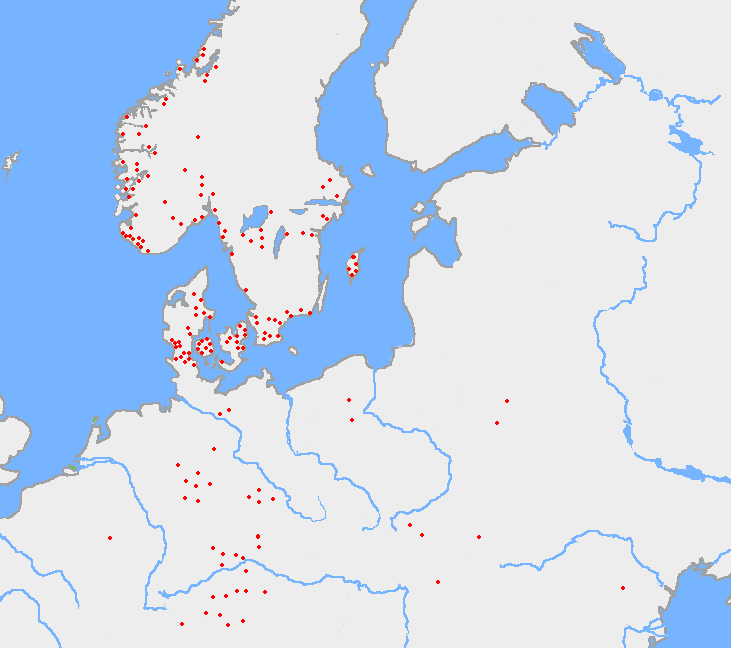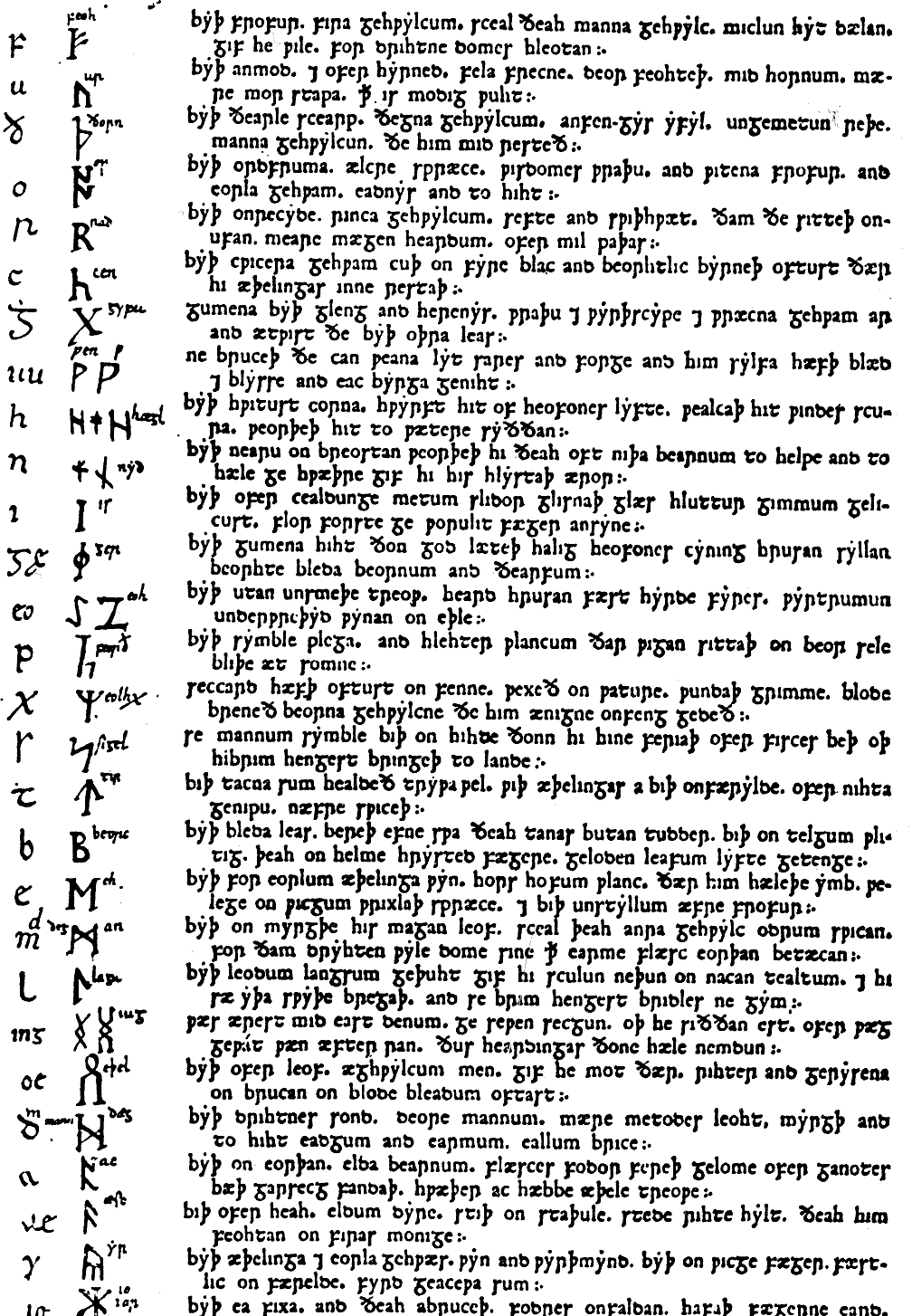|
Algiz
Algiz (also Elhaz) is the name conventionally given to the "''z''-rune" of the Elder Futhark runic alphabet. Its transliteration is ''z'', understood as a phoneme of the Proto-Germanic language, the terminal ''*z'' continuing Proto-Indo-European terminal ''*s''. It is one of two runes which express a phoneme that does not occur word-initially, and thus could not be named acrophonically, the other being the ''ŋ''-rune Ingwaz . As the terminal ''*-z'' phoneme marks the nominative singular suffix of masculine nouns, the rune occurs comparatively frequently in early epigraphy. Because this specific phoneme was lost at an early time, the Elder Futhark rune underwent changes in the medieval runic alphabets. In the Anglo-Saxon futhorc it retained its shape, but it was given the sound value of Latin ''x''. This is a secondary development, possibly due to runic manuscript tradition, and there is no known instance of the rune being used in an Old English inscription. In Proto-Nor ... [...More Info...] [...Related Items...] OR: [Wikipedia] [Google] [Baidu] |
Elder Futhark
The Elder Futhark (or Fuþark), also known as the Older Futhark, Old Futhark, or Germanic Futhark, is the oldest form of the runic alphabets. It was a writing system used by Germanic peoples for Northwest Germanic dialects in the Migration Period. Inscriptions are found on artifacts including jewelry, amulets, plateware, tools, and weapons, as well as runestones in Scandinavia, from the 2nd to the 10th centuries. In Scandinavia, beginning in the late 8th century, the script was simplified to the Younger Futhark, while the Anglo-Saxons and Frisians instead extended it, giving rise to the Anglo-Saxon futhorc. Both the Anglo-Saxon futhorc and the Younger Futhark remained in use during the Early and the High Middle Ages respectively, but knowledge of how to read the Elder Futhark was forgotten until 1865, when it was deciphered by Norwegian scholar Sophus Bugge. Description The Elder Futhark (named after the initial phoneme of the first six rune names: F, U, Þ, A, R and ... [...More Info...] [...Related Items...] OR: [Wikipedia] [Google] [Baidu] |
Alcis (gods)
The Alcis ( Proto-Germanic *') were a pair of young brothers worshipped by the Naharvali, an ancient Germanic tribe. Name and origin According to some scholars, the name ''Alcis'' should be interpreted as a Latinized form of Proto-Germanic ''*'' (or ''*''), meaning ' elk (''Alces alces'')' (cf. Old Norse ''elgr,'' Old English ''eolh'', Old High German ''elaho''). This would make the Alcis brothers the elk- or stag-gods. Other scholars propose to link *' to the Germanic root *''alh''- (cf. Goth. ''alhs'' 'temple', Old English ''ealgian'' 'to protect'; further Lith. '' alkas'' 'holy grove'), and thus to interpret the Alcis as 'protective' deities. The Alcis are generally regarded as a reflex of the Divine Twins, a pair of Indo-European youthful horsemen. This may give support to the interpretation of the Alcis as elk-shaped or elk-gods, even though the widespread description of the Divine Twins as rescuers, healers and protectors in other Indo-European mythologies does not ... [...More Info...] [...Related Items...] OR: [Wikipedia] [Google] [Baidu] |
Gothic Alphabet
The Gothic alphabet is an alphabet used for writing the Gothic language. Ulfilas (or Wulfila) developed it in the 4th century AD for the purpose of translating the Bible. The alphabet essentially uses uncial forms of the Greek alphabet, with a few additional letters to express Gothic phonology: * Latin F and G * a questionably Runic letter to distinguish the glide from vocalic * the letter hwair () to express the Gothic labiovelar. Origin Ulfilas is thought to have consciously chosen to avoid the use of the older Runic alphabet for this purpose, as it was heavily connected with pagan beliefs and customs. Also, the Greek-based script probably helped to integrate the Gothic nation into the dominant Greco-Roman culture around the Black Sea. Letters Below is a table of the Gothic alphabet. Two letters used in its transliteration are not used in current English: thorn '' þ'' (representing ), and hwair (representing ). As with the Greek alphabet, Gothic letters were al ... [...More Info...] [...Related Items...] OR: [Wikipedia] [Google] [Baidu] |
Proto-Norse Language
Proto-Norse (also called Ancient Nordic, Ancient Scandinavian, Ancient Norse, Primitive Norse, Proto-Nordic, Proto-Scandinavian and Proto-North Germanic) was an Indo-European language spoken in Scandinavia that is thought to have evolved as a northern dialect of Proto-Germanic in the first centuries CE. It is the earliest stage of a characteristically North Germanic language, and the language attested in the oldest Scandinavian Elder Futhark inscriptions, spoken from around the 2nd to the 8th centuries CE (corresponding to the late Roman Iron Age and the Germanic Iron Age). It evolved into the dialects of Old Norse at the beginning of the Viking Age around 800 CE, which later themselves evolved into the modern North Germanic languages ( Faroese, Icelandic, the three Continental Scandinavian languages, and their dialects). Phonology Proto-Norse phonology probably did not differ substantially from that of Proto-Germanic. Although the phonetic realisation of several ... [...More Info...] [...Related Items...] OR: [Wikipedia] [Google] [Baidu] |
International Phonetic Alphabet
The International Phonetic Alphabet (IPA) is an alphabetic system of phonetic transcription, phonetic notation based primarily on the Latin script. It was devised by the International Phonetic Association in the late 19th century as a standardized representation of speech sounds in written form.International Phonetic Association (IPA), ''Handbook''. The IPA is used by lexicography, lexicographers, foreign language students and teachers, linguistics, linguists, speech–language pathology, speech–language pathologists, singers, actors, constructed language creators, and translators. The IPA is designed to represent those qualities of speech that are part of wiktionary:lexical, lexical (and, to a limited extent, prosodic) sounds in oral language: phone (phonetics), phones, phonemes, Intonation (linguistics), intonation, and the separation of words and syllables. To represent additional qualities of speech—such as tooth wiktionary:gnash, gnashing, lisping, and sounds made wi ... [...More Info...] [...Related Items...] OR: [Wikipedia] [Google] [Baidu] |
Younger Futhark
The Younger Futhark, also called Scandinavian runes, is a runic alphabet and a reduced form of the Elder Futhark, with only 16 characters, in use from about the 9th century, after a "transitional period" during the 7th and 8th centuries. The reduction, somewhat paradoxically, happened at the same time as phonetic changes that led to a greater number of different phonemes in the spoken language, when Proto-Norse evolved into Old Norse. Also, the writing custom avoided carving the same rune consecutively for the same sound, so the spoken distinction between long and short vowels was lost in writing. Thus, the language included distinct sounds and minimal pairs that were written the same. The Younger Futhark is divided into long-branch (Danish) and short-twig (Swedish and Norwegian) runes; in the 10th century, it was further expanded by the "Hälsinge Runes" or staveless runes. The lifetime of the Younger Futhark corresponds roughly to the Viking Age. Their use declined after ... [...More Info...] [...Related Items...] OR: [Wikipedia] [Google] [Baidu] |
Carex
''Carex'' is a vast genus of more than 2,000 species of grass-like plants in the family Cyperaceae, commonly known as sedges (or seg, in older books). Other members of the family Cyperaceae are also called sedges, however those of genus ''Carex'' may be called true sedges, and it is the most species-rich genus in the family. The study of ''Carex'' is known as caricology. Description All species of ''Carex'' are perennial, although some species, such as '' C. bebbii'' and '' C. viridula'' can fruit in their first year of growth, and may not survive longer. They typically have rhizomes, stolons or short rootstocks, but some species grow in tufts ( caespitose). The culm – the flower-bearing stalk – is unbranched and usually erect. It is usually distinctly triangular in section. The leaves of ''Carex'' comprise a blade, which extends away from the stalk, and a sheath, which encloses part of the stalk. The blade is normally long and flat, but may be folded, inrolled, ... [...More Info...] [...Related Items...] OR: [Wikipedia] [Google] [Baidu] |
Zeta
Zeta (, ; uppercase Ζ, lowercase ζ; grc, ζῆτα, el, ζήτα, label=Demotic Greek, classical or ''zē̂ta''; ''zíta'') is the sixth letter of the Greek alphabet. In the system of Greek numerals, it has a value of 7. It was derived from the Phoenician letter zayin . Letters that arose from zeta include the Roman Z and Cyrillic З. Name Unlike the other Greek letters, this letter did not take its name from the Phoenician letter from which it was derived; it was given a new name on the pattern of beta, eta and theta. The word ''zeta'' is the ancestor of ''zed'', the name of the Latin letter Z in Commonwealth English. Swedish and many Romanic languages (such as Italian and Spanish) do not distinguish between the Greek and Roman forms of the letter; "''zeta''" is used to refer to the Roman letter Z as well as the Greek letter. Uses Letter The letter ζ represents the voiced alveolar fricative in Modern Greek. The sound represented by zeta in Greek before 40 ... [...More Info...] [...Related Items...] OR: [Wikipedia] [Google] [Baidu] |
Eihwaz
Eiwaz or Eihaz is the reconstructed Proto-Germanic name of the rune , coming from a word for "yew". Two variants of the word are reconstructed for Proto-Germanic, ''*īhaz'' (''*ē2haz'', from Proto-Indo-European '), continued in Old English as (also ), and ''*īwaz'' (''*ē2waz'', from Proto-Indo-European '), continued in Old English as ''īw'' (whence English '). The latter is possibly an early loan from the Celtic, compare Gaulish ''ivos'', Breton ''ivin'', Welsh ''ywen'', Old Irish '' ēo''. The common spelling of the rune's name, "Eihwaz", combines the two variants; strictly based on the Old English evidence, a spelling "Eihaz" would be more proper. Following the convention of Wolfgang Krause, the rune's standard transliteration today is ''ï'', though this designation is somewhat arbitrary as the rune's purpose and origin is still not well understood. Elmer Antonsen and Leo Connolly theorized that the rune originally stood for a Proto-Germanic vowel lost by the time of t ... [...More Info...] [...Related Items...] OR: [Wikipedia] [Google] [Baidu] |
Wilhelm Grimm
Wilhelm Carl Grimm (also Karl; 24 February 178616 December 1859) was a German author and anthropologist, and the younger brother of Jacob Grimm, of the literary duo the Brothers Grimm. Life and work Wilhelm was born in February 1786 in Hanau, in Hesse-Kassel. In 1803, he started studying law at the University of Marburg, one year after his brother Jacob started there. The two brothers spent their entire lives close together. In their school days, they had one bed and one table in common; as students, they had two beds and two tables in the same room. They always lived under one roof and had their books and property in common. In 1825, 39-year-old Wilhelm married pharmacist's daughter Henriette Dorothea Wild, also known as Dortchen. Wilhelm's marriage did not change the harmony of the brothers. Richard Cleasby visited the brothers and observed, "they both live in the same house, and in such harmony and community that one might almost imagine the children were common property. ... [...More Info...] [...Related Items...] OR: [Wikipedia] [Google] [Baidu] |
Anglo-Saxon Rune Poem
The Old English rune poem, dated to the 8th or 9th century, has stanzas on 29 Anglo-Saxon runes. It stands alongside younger rune poems from Scandinavia, which record the names of the 16 Younger Futhark runes. The poem is a product of the period of declining vitality of the runic script in Anglo-Saxon England after the Christianization of the 7th century. A large body of scholarship has been devoted to the poem, mostly dedicated to its importance for runology but to a lesser extent also to the cultural lore embodied in its stanzas. The sole manuscript recording the poem, Cotton Otho B.x, was destroyed in the Cotton Fire of 1731, and all editions of the poems are based on a facsimile published by George Hickes in 1705. History of preservation The poem as recorded was likely composed in the 8th or 9th century.Van Kirk Dobbie (1965:XLIX). It was preserved in the 10th-century manuscript Cotton Otho B.x, fol. 165a – 165b, housed at the Cotton library in London. The first mentio ... [...More Info...] [...Related Items...] OR: [Wikipedia] [Google] [Baidu] |




